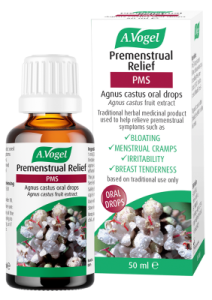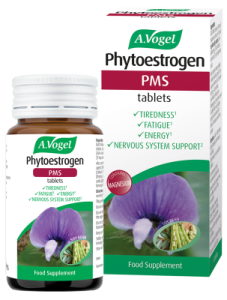From back and lower abdominal pain, to bloating, breast tenderness, irritability and mood swings, the symptoms of PMS are varied, but help is available – and it doesn’t necessarily require you popping a pill.

Help with PMS cramps
Possibly the most common symptoms of PMS are menstrual cramps around your abdomen and lower back pain. These happen when the muscles of your womb contract and relax to help shed built-up lining.
Some women experience intense abdominal cramping, for others the pain is much milder. Factors associated with more intense pain include having a heavy menstrual flow, being under the age of 20 or just starting your period, and having an overproduction of or sensitivity to prostaglandins, a type of fatty acid that can have a hormone-like effect, especially on the womb. Endometriosis and adenomyosis can also cause incredibly painful cramping.
For mild to temporary cramps, heat in the form of a hot water bottle or heat pack can help. One study found that heat therapy was as effective at treating menstrual pain as NSAIDs.
Herbal teas can also help with menstrual cramps. Research shows that chamomile tea increases urinary levels of glycine, which helps to relieve muscle spasms. Glycine also acts a nerve relaxant. Try sipping two cups of chamomile tea per day a week before your period.
 There has also been a lot of research into Agnus castus, a medicinal plant also known as Chaste Tree or Chasteberry. Extracts of the Agnus castus fruit have a long tradition of use in helping with both emotional and physical symptoms of PMS, including cramps. A.Vogel’s Premenstrual Relief Agnus Castus Oral Drops, provide 500mg of Agnus castus extract per dose. A traditional herbal remedy, they are registered for use to help relieve symptoms of PMS, including menstrual cramps, breast tenderness and bloating.
There has also been a lot of research into Agnus castus, a medicinal plant also known as Chaste Tree or Chasteberry. Extracts of the Agnus castus fruit have a long tradition of use in helping with both emotional and physical symptoms of PMS, including cramps. A.Vogel’s Premenstrual Relief Agnus Castus Oral Drops, provide 500mg of Agnus castus extract per dose. A traditional herbal remedy, they are registered for use to help relieve symptoms of PMS, including menstrual cramps, breast tenderness and bloating.
Bloating as a result of PMS
If you do suffer from bloating, following a ‘PMS diet’ can also help. Consisting of wholegrains for energy and fibre, fresh fruit for a source of natural sugars, vegetables for a nutrient top-up, nuts – preferably plain – for protein and because they’re a great source of healthy fats, and oily fish and flax seeds for a boost of omega-3s, the so-called PMS diet may help enormously with the symptoms of PMS.
Eating smaller but more regular meals will also help with feelings of fullness.
Balancing your hormones to reduce PMS
Are you oestrogen-dominant or progesterone-dominant? You may not experience either hormonal dominance, but many women do, and both are patterns that can be adjusted with natural remedies and strategies.
Oestrogen dominance is associated with the more classic symptoms of PMS, such as heavy bleeds, lots of pain, breast discomfort, irritability and angry moods. Progesterone dominance features lighter and sometimes shorter bleeds but low mood, low energy levels, skin breakouts, and emotional sensitivity.
If you find yourself falling into the oestrogen-dominant camp, you may benefit from an Agnus castus supplement and also a natural iron tonic, especially if your periods are very heavy. Iron-rich foods, such as dried fruits and green leafy veg, may also help.
If your monthly is more progesterone-fuelled, some phytoestrogen support in the form of soy isoflavones, natural oestrogens derived from plants, may be helpful for you. A.Vogel’s Phytoestrogen PMS Tablets provide soy isoflavones as well as magnesium and hibiscus, to ease symptoms such as tiredness and fatigue.
natural oestrogens derived from plants, may be helpful for you. A.Vogel’s Phytoestrogen PMS Tablets provide soy isoflavones as well as magnesium and hibiscus, to ease symptoms such as tiredness and fatigue.
Phytoestrogenic foods, including flaxseeds, sesame seeds, cruciferous veg and peaches, may also help.
For further information on any aspect of men’s health, visit Jay Thankey at Natural Health, 339 Ballards Lane, North Finchley, or call 020 8445 4397.


